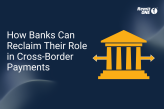Predictions for the Money Transfer Industry in 2022 January 25, 2022

Recent years have certainly reshaped the world of money transfers. The pandemic presented new challenges and the industry responded with innovative solutions. In 2020, we saw a great demand for mobile and online payments, driven by Covid-imposed restrictions worldwide – an astonishing 62% of banking customers considered switching from physical to digital platforms in 2020 alone [1]. It’s clear that this pace of change is showing no sign of stopping, so let’s explore the new trends and our predictions for 2022.
Cash v Digital: The Consequence of an Age-Old Question
An answer commonly sought in the money transfer space is whether the competition between cash and digital money transfer finally has a winner. Although it’s clear that cash isn’t going anywhere yet [2], digital remittances are continuing to rise, even outside the peak of the pandemic.
Customers and Money transfer Operators (MTOs) alike value convenience, security and cost-effectiveness; all of which can be easily offered by mobile and online payment systems. For example, eKYC, digital AML, payment gateway and other 3rd party API solutions solve regulatory issues and give instant access to remitter, beneficiary and payment information. In addition, they also allow for changes to exchange rates while offering transparency to supply chain members and automating manual tasks.
As more MTOs enter the mobile money transfer space [3] – and the number of people with access to mobile devices increases [4] – digital money transfers will continue to evolve and thrive. This evolution has already made the role of technology solutions providers in this space mandatory. As a consequence, we predict we’ll be seeing these providers become a permanent part of the supply chain landscape.
Rise of Money Transfer Machines
Over the past 2 years, the money transfer industry has witnessed an array of technology features – that normally would have taken years to develop – reach the market within just a matter of months. Features such as Artificial Intelligence (AI), Big Data, Blockchain, Digital Wallets, Machine Learning (ML) and Open Banking are all entering the money transfer space. As a result, the role of technology solutions providers is becoming a mainstay in the landscape, and we can expect 2022 to be the year where these features are implemented.
The Uptake of Blockchain Technology
Most recently, there has been an increased use of blockchain-based technology for cross-border payments. The decentralised nature of blockchain not only speeds up transactions and reduces costs, but also has inherent security features which are tough to breach [5]. In addition, blockchain technology has an innate value that can eliminate the need for pre-funding in money transfers. Consequently, it can eliminate the biggest stumbling blocks for fintech start-ups in the money transfer space.
Open Banking
Another feature we’re currently seeing increasingly utilised in Europe is Open Banking. With the ability to connect banks, technical providers, aggregators and other 3rd parties, Open Banking has allowed for a more seamless, transparent, secure and cost-effective experience for individuals.
Open Banking-powered money transfers appear to be improving the entire customer experience, reducing transaction costs and processing speeds in comparison to more traditional methods of payment. With the growing demand for improvement we’re currently seeing, it comes as no surprise that this is one trend we’re expecting to thrive.
Mobile Wallets
We’re also expecting that the definition of a mobile wallet will change in 2022. Whether it’s a send or receive market, the wallet functionality will add a host of services, including utility bill payments, airtime top-ups, micro-loans and wallet settlements. The digital wallet is en route to becoming a universal mobile bank account, through which all daily transactions of varying types will occur, regardless of where the individual is based.
What can we expect now?
Companies from neighbouring verticals such as hospitality, travel and telecoms are considering diversifying their product and service portfolios. Telcos, for example, are exploring ways to offer their own proprietary wallet with a variety of features, including money transfers, to customers. Taxi businesses are a further example of companies that are opening up remittance channels, so their drivers who are paid into wallets can send money directly from the wallet to their loved ones.
As a result, we can expect new alliances between previously disconnected verticals to take root. We can expect a rise in more Fintechs using a plug-and-play model to deliver a new breed of services involving money transfers. And finally, we can expect more aggregators to facilitate open-loop payments with instant delivery times.
To conclude, the main thing we’re predicting this year is diversification. From Open Banking and digital payment solutions to the coming together of firms from different verticals, we’re predicting more opportunities for Telcos, retail shops, MTOs, aggregators to deliver value to the customer through the digital wallet. The customer – the individual with a digital wallet – has never been in a better position to avail a variety of fully transparent services at cost-effective rates.
References
[1] https://newsroom.mastercard.com/eu/documents/mastercard-evolution-of-banking-2020-infographic/
[2] [3] https://www.remitone.com/ipr-report-2021/
[4] https://www.statista.com/statistics/330695/number-of-smartphone-users-worldwide/
[5] https://www.ibm.com/uk-en/topics/blockchain-security
What next?
Now that you’ve read our article we want to help you get the most out of it and plan for 2022.
Tap into our experts and schedule a free consultation.
Related Posts
-

How to Build a Leaner, Smarter Money Service Business in 2025
In an era of rapid regulatory change, rising customer expectations, and digital disruption, how can money service businesses (MSBs)—companies that…
May 22, 2025 -

Trump’s Threats to Cross-Border Payments: What It Means for Your Business
It’s been a short while since Trump stormed back into office, and he’s already shaken things up with his hard-hitting…
May 22, 2025 -

Unlock Faster, More Secure Payments with RemitONE’s Open Banking Solution
We’re excited to introduce the latest enhancement to our RemitONE Money Transfer Platform: the RemitONE Open Banking Solution. Competitively priced…
January 31, 2025 -

How to Expand Your SEND Operations in the UK and Europe—Without the Regulatory Hassle
The remittance market in Europe is valued at €133.7 billion annually, with the UK market contributing an additional £23 billion.
January 31, 2025 -

The Top 5 Cross-Border Payment Trends That Shaped 2024
What a year it’s been for the world of payments! From breakthroughs in tech to surprising shifts in consumer behaviour,…
December 19, 2024 -

How Banks Can Reclaim Their Role in Cross-Border Payments with RemitONE
Banks, once the cornerstone of international payments, are finding themselves sidelined. Senders and receivers have now joined forces, pushing banks…
December 18, 2024